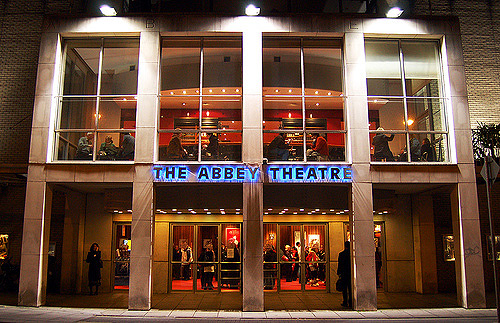
In the play At The Black Pig’s Dyke, a tale of generational violence in Northern Ireland that premiered at Druid in 1998, “revenge is the longest road” are words spoken by a grieving widow. These words could easily have appeared in Frances Poet’s What Put the Blood, first staged in 2015 and now appearing at the Peacock for a short run directed by the Abbey’s Director, Graham McLaren.
Unfortunately, one could also believe that Poet’s play was written in the same decade as Dyke. Woods’ play, even in 1998, arrived late to the genre of the classical epic re-set in rural Ireland, which was already well-mined by Frank McGuinness, Marina Carr and Sebastian Barry. Although What Put the Blood, a contemporary(ish) adaptation of Jean Racine’s Andromaque, bears strong similarities to Marina Carr’s early Midland plays, it lacks the biting social satire that gives Carr’s plays their relevance, instead choosing to wallow in its own torrid passions.
What Put the Blood tells the tale of Andromaque, a housewife from the North, and Hermione, a pampered princess from the South. A blood feud erupts between their families after Hermione’s mother, Queenie, runs away with Andromaque’s brother-in-law, Peacock. A man named Killer and his son Red are hired by Hermione’s father to track the couple down, arriving at Andromaque’s house, where her husband, Hammer, is killed by Killer for hiding his brother, but not before he curses him with his last words, leaving Killer dead three days later.
Confused? I’ll give Poet the benefit of the doubt by saying that you should be. The web of vengeance that encircles the protagonists is a complex one and the first 10 minutes of the play are spent trying to grasp it. However, we do begin to grasp that the detail is not so important as the knowledge that the passions which propel this drama have a very complicated origin. The meat of the play centres on Hermione’s intended marriage to Red, the reasons for why it got complicated and the consequences of an ensuing bloodshed.
McLaren has Lucianne McEvoy and Julie Rogers, playing Hermione and Andromaque respectively, who perform the entire play from chairs atop wooden pallets. They appear to have been taken captive by mafia-like forces who interrogate them about the details of Hermione and Red’s wedding, although it is never clear whether it is the same force which has captured both of them or even whether the force which has taken them captive is their own family. McEvoy and Rogers deliver detailed and ranging performances which, despite their intensity, allow moments of welcome comic relief. They even handle convincingly Poet’s inclination towards inverted sentence structures, a technique which appears to have been employed in order to give an archaic gloss to the dialogue.
The design, also by McLaren, evokes an abattoir with butchers’ curtains and hooks ominously spattered with blood creating a shallow and claustrophobic stage space. The shifts in location are efficiently handled by the lighting and sound team, although it is never stated why Andromaque and Hermione are moved during their interrogation.
While Poet’s play is an engaging and visceral story of human (or animal?) passion, what fails to emerge from the carnage is an answer to the most basic question one can ask in the face of horror: why?






